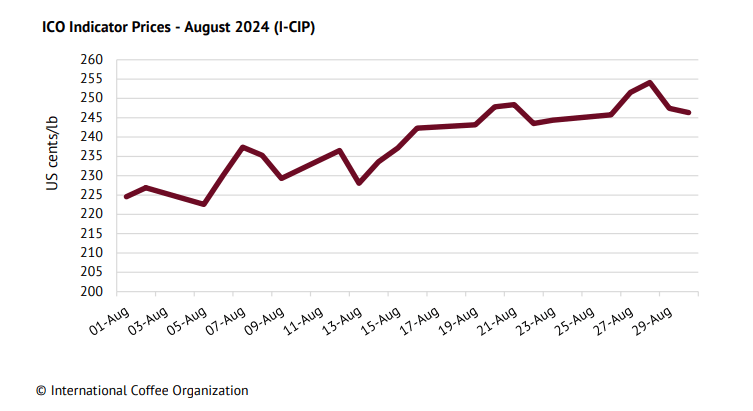Coffee prices hit record highs: how climate change and EU regulations have affected your favorite drink

You are scrolling through the morning news feed, enjoying the taste of your favorite coffee, and suddenly you come across a message about the increase in the price of coffee beans. You sigh sadly, because the iconic drink has long become a part of the mandatory morning ritual, and a cup of delicious coffee in the afternoon is not superfluous. And here you find out why each portion of coffee will now cost more. And not just at your local establishment; coffee prices are rising all over the world. Why? The real reason lies in several key factors. Coffee beans, the heart of every cup of your favorite drink, are becoming more expensive. And it’s not just about the grains themselves; the entire journey from farm to coffee shop is burdened with rising costs. All coffee logistics are becoming more expensive. Let’s delve into this question. Beyond grains, the supply chain plays a huge role in rising prices. From the moment the coffee is collected until it reaches the cup of a certain coffee lover, each stage has its own costs. Labor and production costs are rising, especially in regions known for high-quality coffee.
Impact of global prices on coffee beans
When it comes to the cost of coffee, the role of global coffee bean prices cannot be ignored. Thanks to platforms like Getty Images, we can see how Robusta and Arabica beans are sold around the world. These visuals not only illustrate the trading process, but also demonstrate price fluctuations and the unpredictability of the market. Images tell us the story of what we directly pay for in coffee shops.
CNN tells the story of the Edelman family farm, which is located in the highlands of Chiapas in southern Mexico. Here, about 150 coffee farmers work with their hands, long and hard, under the only protection from the scorching summer sun – the shade of trees.
Thomas Edelman, a fourth-generation farmer and vice president of the International Coffee Farmer’s Co-op, explained to CNN that their method of growing coffee in the shade, while drought-tolerant, was unable to cope with the longer-than-normal dry season he linked to climate change. This led to the fact that this year’s harvest was significantly affected.
“If the weather isn’t right, there won’t be the right produce.” – he said. “And with a low harvest, of course, production costs increase.”
How difficult and thankless is the work of workers who grow coffee beans, we will learn on the website International Association of Coffee Farmers, which provides disheartening statistics and outlines the problems: according to a World Bank report, 66% of coffee farmers live in poverty, with 44% of smallholder farmers surviving on $3.20 a day and 22% living in extreme poverty, receiving only $1.90 a day. The association aims to improve the lives of 125,000 farmers by paying them more than they spend on production and increasing their yields to over 25 quintals per hectare by April 2040. An ambitious goal, because today the yield of coffee is about 15-20, sometimes 23 centners per hectare.
The International Coffee Organization, established in 1963 with the support of the United Nations, reported that the ICO Composite Indicator Price – a key reference price for the global coffee industry – reached a 13-year high in July of this year, averaging $2.27 per pound. View data of this organization for the past month allows us to talk about a new price record: on August 27, the price per pound jumped to $2.55.

“Coffee is a very complex commodity. Part of the reason is that you have multiple supply and demand systems that affect the price.”,” explained Ryan Delaney, founder and chief analyst at Coffee Trading Academy.
Global warming against coffee
Global warming threatens world coffee supplies. Temperatures are rising and rainfall patterns are changing in South America, Central Africa and Southeast Asia, where most of the world’s coffee is grown. By according to The Economist, by the end of the century between 35% and 75% of the coffee area in Brazil, the largest coffee producer, may be unusable. Another thematic paper, published in 2015, stated that by 2050, 43% to 58% of the world’s land used for coffee cultivation could become unusable. It will depend on how much greenhouse gas levels rise.
Coffee is much more sensitive to temperature changes than many other crops, says Michael Hoffman, a professor at Cornell University’s College of Agriculture. Recent climate events have had a negative impact on coffee production.
Climate change is worsening, and this is manifesting itself in rising temperatures and increasingly harsh weather conditions for crop production. Climate change also has a direct impact on the people who work on coffee plantations. As a result of such changes, coffee will become more and more expensive for consumers.
Coffee experts often joke that when Brazil sneezes, the rest of the world gets sick. This is a nod to its status as the largest producer of Arabica, a premium coffee variety that accounts for more than 60% of all coffee production.
For example, when an unusually severe frost wiped out its crop in the summer of 2021, the coffee market experienced an immediate supply shock, with US Arabica coffee futures hitting a record 260 cents a pound.
It is not uncommon to see coffee consumers switch from Arabica to Robusta, a cheaper type of bean used in instant coffee. As the name suggests, robusta is a much hardier plant than its counterpart. However, despite its ability to withstand prolonged droughts, recent crops have been affected by droughts and above-normal temperatures. In general, when Arabica grows, so does Robusta. At the same time, with Arabica prices held at sustained highs, demand for Robusta is beginning to outpace demand for Arabica.
In general, climate change affects the coffee market regardless of its variety.
International Coffee Organization is actively working with the G7 to improve climate change adaptation and sustainability in the coffee value chain. The Italian presidency of the G7 defined coffee as a strategic commodity. At the meeting of G7 development ministers in Pescara on October 24-25, 2024, it is planned to establish a coffee sustainability fund.
Why we should expect a further increase in coffee prices
Coffee prices, which have already reached record levels, may rise even more, Italian coffee giant Lavazza warns in reports of the Financial Times. According to company representatives, several factors influence the increase in the price of coffee: climate change, supply disruptions and new EU regulations.
Climate change, which leads to unpredictable weather conditions and adversely affects coffee harvests, is a major factor driving up prices. In addition, problems with the transportation of coffee complicate its delivery and increase costs. The new regulatory policy of the EU also makes adjustments, increasing the costs of coffee processing and delivery. It is about banning the import of coffee and other six types of goods grown in forestless areas. The EU imposes restrictions on the import of certain goods if they are grown or manufactured in regions where deforestation has occurred. This applies to products such as coffee, soy, cocoa and palm oil. The purpose of these regulations is to ensure that products entering the European market are produced in a sustainable manner, which helps preserve forests and ecosystems. These new requirements are forcing farmers in producing countries to change their farming practices to meet EU standards.
Consequently, consumers can expect coffee prices to rise even further, which will affect the cost of their favorite drink. Currently, coffee is grown in more than 70 countries of the world, coffee lovers drink more than 2 billion cups every day. Agree, the figure is too big for mankind not to notice the problem with the reduction of the world’s coffee supply and not react to it properly.





